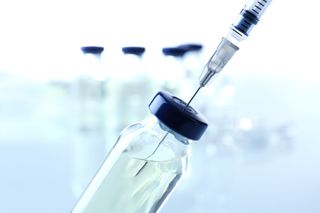Can You Still Get the Measles If You've Been Vaccinated?

The number of measles cases in the U.S. continues to climb, with more than 550 cases reported from January to April, according to the Centers for Disease Control and Prevention (CDC). That's the second highest number of measles cases reported in any year since 2000, the CDC says.
Many of this year's cases occurred as part of ongoing measles outbreaks in several U.S. cities, and most infected people were unvaccinated, according to the CDC. But if you've been vaccinated, can you still catch the disease?
Although it is possible to get the measles even if you've been vaccinated, it's quite rare: Two doses of the measles, mumps and rubella (MMR) vaccine — which are given as part of the standard U.S. childhood vaccination schedule — are 97% effective at preventing measles, according to the CDC. This means that about 3% of people who receive two doses of the measles vaccine will get measles if they are exposed to the virus. [27 Devastating Infectious Diseases]
It's not clear why some fully vaccinated people get measles, but it could be that their immune system did not respond properly to the vaccine, the CDC says. (Still, if a person is fully vaccinated, and they come down with measles, they are more likely to have a mild case of the illness.)
In addition, some people may be at a slightly higher risk of getting measles because they received only one dose of the MMR vaccine. Although the measles vaccine was developed in 1963, it wasn't until 1989 that health officials recommended that a child receive two doses, according to the CDC.
This means there are "many people who are adults now who only received one dose" of MMR, said Dr. Amesh Adalja, a senior scholar at The Johns Hopkins Center for Health Security in Baltimore. One dose of MMR is still more than 90% effective at preventing measles, but it's not quite as good as two doses, Adalja said.
Adults who received only one dose of MMR as a child could consider getting a second dose, Adalja told Live Science. In situations where there are outbreaks going on, "I don't think its a bad idea," he said.
Sign up for the Live Science daily newsletter now
Get the world’s most fascinating discoveries delivered straight to your inbox.
In addition, some people who received the measles vaccine in the 1960s may need to be revaccinated. That's because, between 1963 and 1967, some people received a form of the measles vaccine known as the "inactivated" (killed) vaccine, which was not effective, according to the CDC. People who received this form of the vaccine, or were vaccinated before 1968 and don't know what vaccine type they got, should be revaccinated with the current "live attenuated" form of the vaccine, the CDC says.
Waning immunity?
Another question people may have is whether the vaccine's protection wanes over time. Generally, people who've received two doses of MMR are considered protected for life, meaning they don't need a booster shot, according to the CDC.
Still, there may be some waning that happens with age, Adalja said.
There is a way to check your level of protection against measles. You can get a blood test that measures antibody levels against the measles virus. However, doctors don't routinely use this test on patients — it's more often used for health care workers who are generally at higher risk of being exposed to measles. But it may be used in other situations: for example, for college students who need to show they are immune to measles, according to University of Rochester Medical Center.
Generally, the CDC recommends that people who don't have written documentation of getting the MMR vaccine should get vaccinated. However, people who were born before 1957 are considered likely to be immune to the virus (because most people born at that time were infected naturally with the virus), and therefore don't need to be vaccinated.
Originally published on Live Science.

Rachael is a Live Science contributor, and was a former channel editor and senior writer for Live Science between 2010 and 2022. She has a master's degree in journalism from New York University's Science, Health and Environmental Reporting Program. She also holds a B.S. in molecular biology and an M.S. in biology from the University of California, San Diego. Her work has appeared in Scienceline, The Washington Post and Scientific American.
